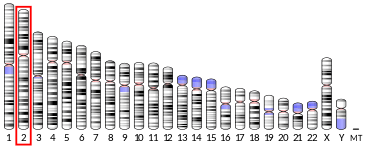SDPR
Cavin-2 or Serum deprivation-response protein (SDPR) is a protein that in humans is encoded by the SDPR gene.[5][6][7] Cavin-2 is highly expressed in a variety of human endothelial cells.[8]
| CAVIN2 | |||||||||||||||||||||||||
|---|---|---|---|---|---|---|---|---|---|---|---|---|---|---|---|---|---|---|---|---|---|---|---|---|---|
| Identifiers | |||||||||||||||||||||||||
| Aliases | CAVIN2, PS-p68, SDR, cavin-2, SDPR, serum deprivation response, caveolae associated protein 2 | ||||||||||||||||||||||||
| External IDs | OMIM: 606728 MGI: 99513 HomoloGene: 3422 GeneCards: CAVIN2 | ||||||||||||||||||||||||
| |||||||||||||||||||||||||
| |||||||||||||||||||||||||
| |||||||||||||||||||||||||
| |||||||||||||||||||||||||
| Orthologs | |||||||||||||||||||||||||
| Species | Human | Mouse | |||||||||||||||||||||||
| Entrez | |||||||||||||||||||||||||
| Ensembl | |||||||||||||||||||||||||
| UniProt | |||||||||||||||||||||||||
| RefSeq (mRNA) | |||||||||||||||||||||||||
| RefSeq (protein) | |||||||||||||||||||||||||
| Location (UCSC) | Chr 2: 191.83 – 191.85 Mb | Chr 1: 51.29 – 51.3 Mb | |||||||||||||||||||||||
| PubMed search | [3] | [4] | |||||||||||||||||||||||
| Wikidata | |||||||||||||||||||||||||
| |||||||||||||||||||||||||
This gene encodes a calcium-independent phospholipid-binding protein whose expression increases in serum-starved cells. This protein has also been shown to be a substrate for protein kinase C (PKC) phosphorylation.[7]
Function
Cavin-2 is required for blood vessel formation (angiogenesis) in humans and zebrafish and required also for the endothelial cell proliferation, migration and invasion in humans.[8] Cavin-2 plays an important role in endothelial cell maintenance by regulating eNOS activity.[8] Cavin-2 controls the generation of nitric oxide (NO) in human endothelial cells by controlling the activity and stability of the protein endothelial nitric-oxide synthase (eNOS).[8]
Secretion
Cavin-2 is highly secreted from human endothelial cells (HUVEC), they are secreted through endothelial microparticles (EMPs) but not exosomes and is required for EMP biogenesis.[8]
Clinical significance
SDPR is shown to act as a metastasis suppressor by xenograft studies utilizing breast cancer cell lines.[9] SDPR may elicit its metastasis suppressor function by directly interacting with ERK and limiting its pro-survival role.[9] Moreover, it is suggested that SDPR is silenced during breast cancer progression by promoter DNA methylation.[9] Metastasis suppressor role of SDPR may go beyond breast cancer since tumor samples from bladder, colorectal, lung, pancreatic, and ovarian cancers as well as sarcomas also exhibited loss of SDPR expression.[9]
References
- GRCh38: Ensembl release 89: ENSG00000168497 - Ensembl, May 2017
- GRCm38: Ensembl release 89: ENSMUSG00000045954 - Ensembl, May 2017
- "Human PubMed Reference:". National Center for Biotechnology Information, U.S. National Library of Medicine.
- "Mouse PubMed Reference:". National Center for Biotechnology Information, U.S. National Library of Medicine.
- Gustincich S, Vatta P, Goruppi S, Wolf M, Saccone S, Della Valle G, Baggiolini M, Schneider C (Jun 1999). "The human serum deprivation response gene (SDPR) maps to 2q32-q33 and codes for a phosphatidylserine-binding protein". Genomics. 57 (1): 120–9. doi:10.1006/geno.1998.5733. PMID 10191091.
- Gustincich S, Schneider C (Dec 1993). "Serum deprivation response gene is induced by serum starvation but not by contact inhibition". Cell Growth Differ. 4 (9): 753–60. PMID 8241023.
- "Entrez Gene: SDPR serum deprivation response (phosphatidylserine binding protein)".
- Boopathy GT, Kulkarni M, Ho SY, Boey A, Chua EW, Barathi VA, Carney TJ, Wang X, Hong W (2017). "Cavin-2 regulates the activity and stability of endothelial nitric oxide synthase (eNOS) in angiogenesis". The Journal of Biological Chemistry. 292: 17760–17776. doi:10.1074/jbc.M117.794743. PMC 5663877. PMID 28912276.
- Sait Ozturk; Panagiotis Papageorgis; Chen Khuan Wong; Arthur W. Lambert; Hamid M. Abdolmaleky; Arunthathi Thiagalingam; Herbert T. Cohen & Sam Thiagalingam (Jan 2016). "SDPR functions as a metastasis suppressor in breast cancer by promoting apoptosis". PNAS. 113: 638–643. doi:10.1073/pnas.1514663113. PMC 4725521. PMID 26739564.
Further reading
- Burgener R, Wolf M, Ganz T, Baggiolini M (1990). "Purification and characterization of a major phosphatidylserine-binding phosphoprotein from human platelets". Biochem. J. 269 (3): 729–34. PMC 1131648. PMID 2390065.
- Cross SH, Charlton JA, Nan X, Bird AP (1994). "Purification of CpG islands using a methylated DNA binding column". Nat. Genet. 6 (3): 236–44. doi:10.1038/ng0394-236. PMID 8012384.
- Mineo C, Ying YS, Chapline C, et al. (1998). "Targeting of Protein Kinase Cα to Caveolae". J. Cell Biol. 141 (3): 601–10. doi:10.1083/jcb.141.3.601. PMC 2132740. PMID 9566962.
- Strausberg RL, Feingold EA, Grouse LH, et al. (2003). "Generation and initial analysis of more than 15,000 full-length human and mouse cDNA sequences". Proc. Natl. Acad. Sci. U.S.A. 99 (26): 16899–903. doi:10.1073/pnas.242603899. PMC 139241. PMID 12477932.
- Gevaert K, Goethals M, Martens L, et al. (2004). "Exploring proteomes and analyzing protein processing by mass spectrometric identification of sorted N-terminal peptides". Nat. Biotechnol. 21 (5): 566–9. doi:10.1038/nbt810. PMID 12665801.
- Brandenberger R, Wei H, Zhang S, et al. (2005). "Transcriptome characterization elucidates signaling networks that control human ES cell growth and differentiation". Nat. Biotechnol. 22 (6): 707–16. doi:10.1038/nbt971. PMID 15146197.
- Gerhard DS, Wagner L, Feingold EA, et al. (2004). "The Status, Quality, and Expansion of the NIH Full-Length cDNA Project: The Mammalian Gene Collection (MGC)". Genome Res. 14 (10B): 2121–7. doi:10.1101/gr.2596504. PMC 528928. PMID 15489334.
- Hillier LW, Graves TA, Fulton RS, et al. (2005). "Generation and annotation of the DNA sequences of human chromosomes 2 and 4". Nature. 434 (7034): 724–31. doi:10.1038/nature03466. PMID 15815621.
- Rual JF, Venkatesan K, Hao T, et al. (2005). "Towards a proteome-scale map of the human protein-protein interaction network". Nature. 437 (7062): 1173–8. doi:10.1038/nature04209. PMID 16189514.




